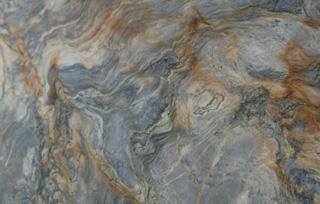 How is marble made?
How is marble made?
Metamorphic rock is a rock that has been
changed by heat and pressure. In this instance, marble, which is formed from
limestone, undergoes a process called recrystallization. The heat and pressure
in the earth's crust causes changes in the composition of the limestone.
Fossilized materials in the limestone, along with its original carbonate
minerals, recrystallize and form large coarse grains. Any impurities that are
present in the limestone during this process affect the formation of the
marble. The resulting minerals determine the variety of the marble.
Marble ranges in colour, is heavily
veined, and shows many grains. Pure white marble is the end product of the
metamorphism of unalloyed limestone. Colours and veining in marble is
determined by the presence of mineral impurities like silt, sand, and iron
oxides (such as hematite and limonite), which previously existed as particles
or deposits in the limestone. Marble is classified into three categories, depending
on the percentage of magnesium carbonate: dolomite, magnesium, and calcite.
Marble is typically named after the
colour of the stone (in Italian) and the location of the quarry from which it
is derived. For example, "Bianco” means white in Italian, and Carrara
is a quarry in Italy; therefore, Bianco Carrara marble is white marble that
comes from the city of Carrara.
Is all marble the same?
"Marble” is an expansive term,
especially with regard to the construction industry. Any partly metamorphosed
limestone, that has a high density and is capable of taking a polish, can be
included in the definition. The construction characterization basically
encompasses most massive crystalline rocks that are durable enough to be used
commercially. This broad characterization is generally accepted, because the
performance and appearance of these rocks is more comparable to marble, than to
the actual scientific classifications of such.
Natural marble is extracted from a
limited number of quarries worldwide and generally imported as slabs. There is
an art to preserving the natural beauty of the stone, and a certain degree of
craftsmanship is required to maintain the esthetic, while using marble as a
building material. Thus, marble is a tremendous luxury, as it is one of the
most expensive materials to use commercially.
In addition to natural stone, there
are man-made alternatives available for consideration, such as cultured marble.
Cultured marble is a precise mixture of fiberglass resin and crushed marble
stone. Whereas the constitution of natural marble is dependent on the
environment for production, having variable shape and colour, cultured marble
can be made to order.
When looking to use marble in your
next project, make sure you visit a reputable company that specializes in the
import and distribution of natural stone, like marble and granite. They will be
able to offer you:
-
Over
30 years of industry experience
-
Superior
service
-
The
largest truck fleet in the business
-
Prompt
and secure delivery Ontario-wide
-
Complete
satisfaction
-
Fair
prices
-
Great
products
-
The
largest selection of the latest materials in the industry
-
Over
300 of the finest stone materials from all over the globe
-
An
assortment of premium marble, granite, quartzite, natural and engineered stone
-
Products
in stock and ready to ship from a massive warehouse
-
Materials
available in both slab and tile
-
Samples
and information available upon request
Marble for the Artwork of life
Marble is one of the most beautiful
building materials on earth and is a highly desirable addition to any home. The
natural splendor of the stone has been used throughout time for both building
materials in construction, and as an art medium.
With proper care and maintenance,
marble can last a lifetime. It is resistant to heat and to breakage. Marble is valued
by pastry chefs, because its surface is cooler than room temperature, and it is
very smooth to allow for ideal pastry manipulation.
In addition to its physical attributes,
marble's primary benefit is its appearance. The iridescence of marble makes it seem
like it is glowing, and the variations of colour and pattern make each piece
unique and provide a timeless feel.
Look to marble for a variety of home
décor projects like:
-
In
the kitchen - flooring, countertops and backsplashes
-
Bathroom
– flooring, countertops, and shower
interiors
-
Laundry
room – flooring and countertops
-
Inside
living and entertainment areas – wall mosaics and bar countertops
-
Outside
living and entertainment areas – patio stones and outdoor bar countertops
Quality companies will be pleased to
show off their wide range of products and discuss your project with you over a
cup of hot espresso!